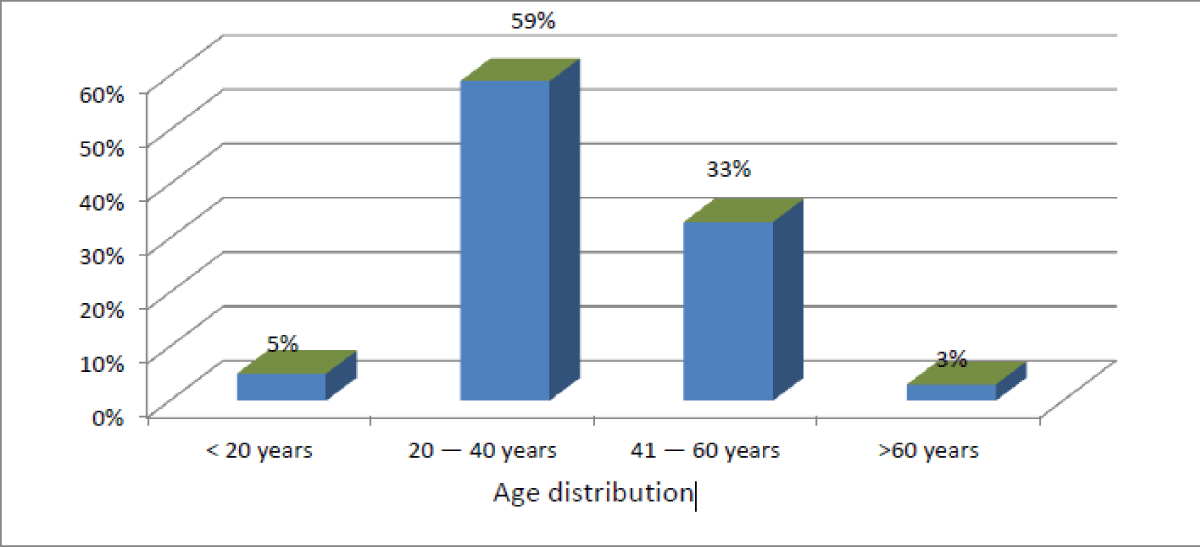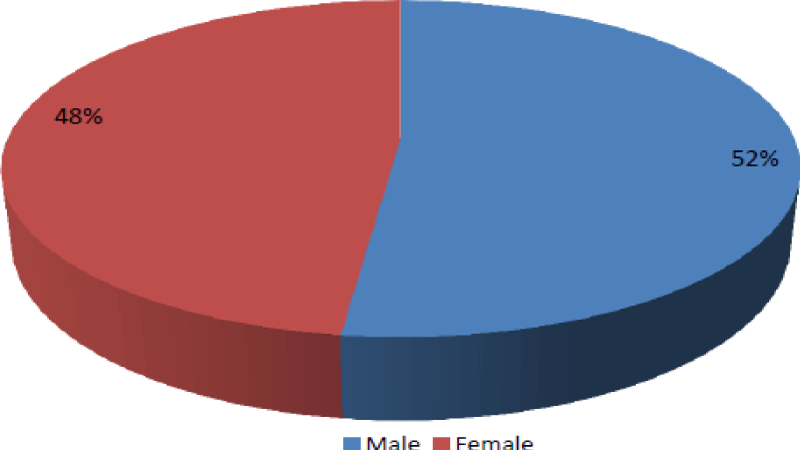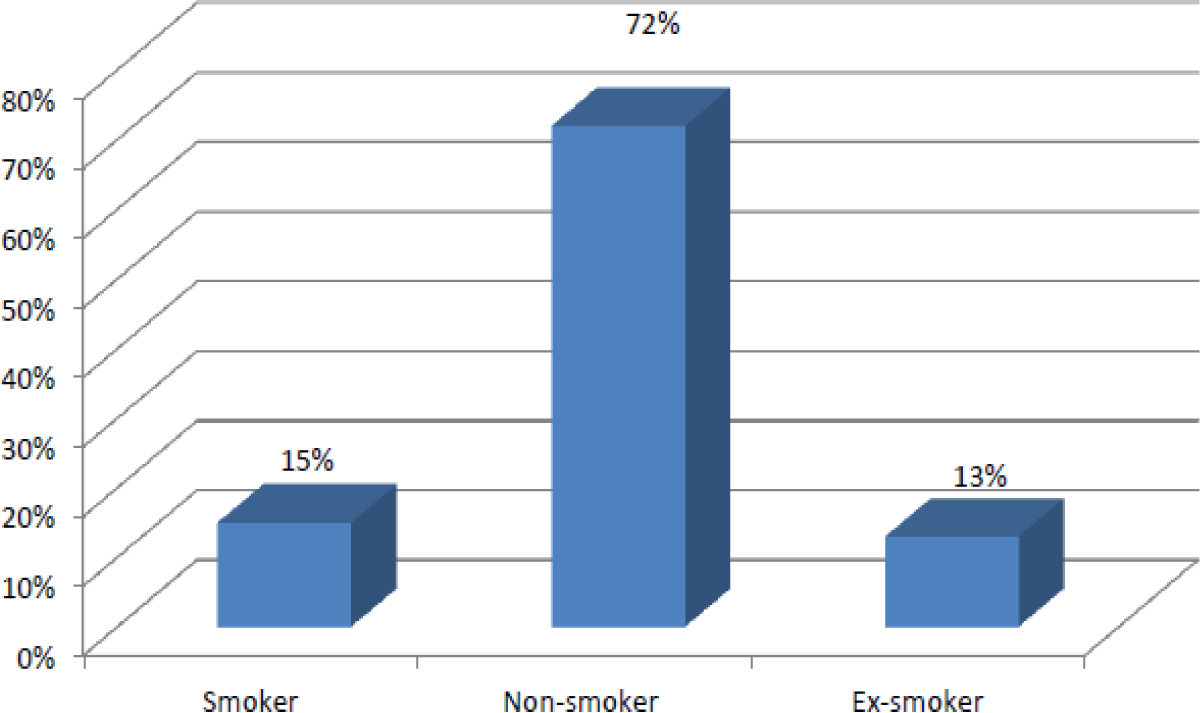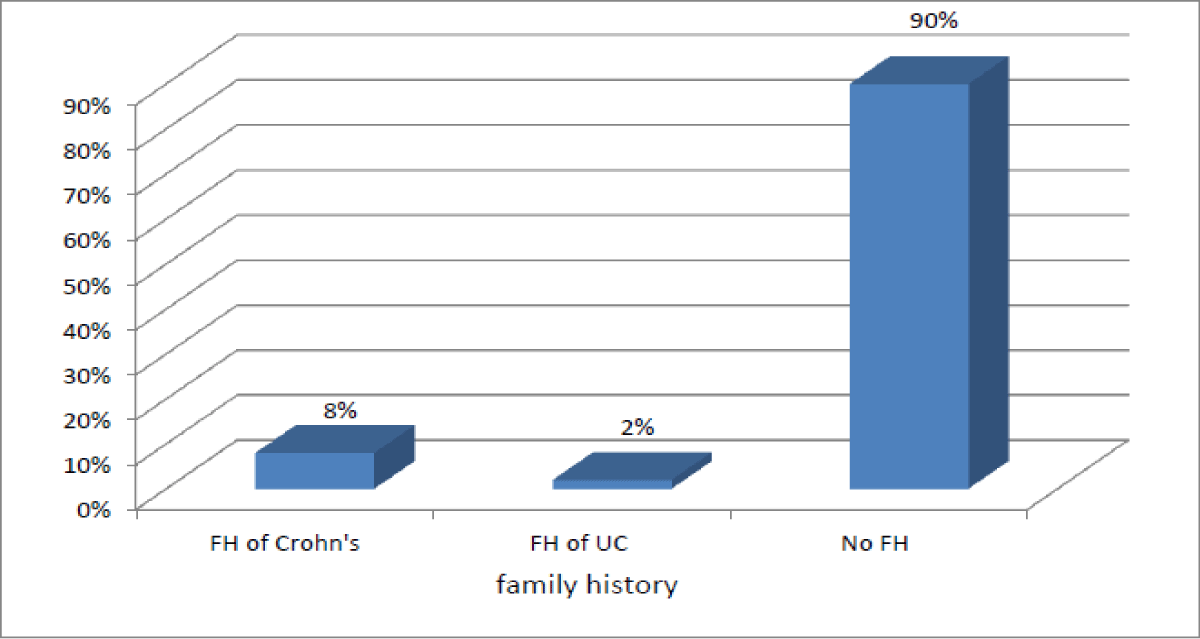Background: Inflammatory bowel disease (IBD) is a chronic, relapsing inflammatory disorder of the gastrointestinal tract that includes two entities, namely Crohn's disease (CD) and ulcerative colitis (UC).
Objective: The aim of the study was to identify the inflammatory bowel disease and significance of the drugs therapy in treatment with behavior of disease.
Method: This study was conducted on 100 patients with inflammatory bowel disease attending Tripoli Medical Center during the period from June 2019 to June 2020. Information was taken from patient files. Statistical analysis was computerized using the Statistical Program for Social Sciences (SPSS version 21) that used for data entry and analysis. A P-value of less than or equal to 0.05 was considered statistically significant.
Result: Regarding the age distribution in this study, the study result revealed that most of the cases were ranged from 20-40 years followed by 41-60 years age group. According to classification of the disease locations, this study classified the disease into four locations as follow: L1 (Terminal ileum) in 29% of cases. L2 (Colon) was found in 19% of cases. L3 (Ileocolon) was the predominant in 43% of cases. L4 (Upper GI) was the less frequency in 9% of cases. The result reported many drugs have been taken by patients, and most of the drugs were taken mixed with other drugs, the common drug was AZA in almost 60% of cases, prednisolone and Mesalamine were existed in about 50% of cases.
Inflammatory, Disorder, Bowel, Treatment, Colon
Inflammatory bowel diseases (IBD) are chronic diseases of the gut with unknown aetiology. Genetically susceptible individuals are thought to have a dysregulated mucosal immune response to commensal gut flora, which results in bowel inflammation [1].
IBD includes ulcerative colitis (UC), Crohn's disease (CD) and IBD unspecified (IBDU), which was formerly termed indeterminate colitis. The term IBDU is applied when no differential diagnosis between UC and CD can be made [2,3]. These entities can be differentiated by their differences in genetic predisposition, risk factors and clinical, endoscopic and histological characteristics [4]. Environmental factors are considered to have a strong role in mediating the risk of IBD, although no single environmental factor has been proven to have a definite causative function [5].
UC is a chronic inflammatory condition causing mucosal inflammation of the colon without granulomas on biopsy, affecting the rectum and a variable extent of the colon, which is characterized by a relapsing and remitting course. Inflammation in UC is restricted to the mucosal surface, but may penetrate deeper in severe course of the disease. Inflammation starts form the rectum and generally extends proximally in a continuous manner through the entire colon. Some patients with proctitis or left-sided colitis have a cecal patch of inflammation [6].
Clinical features: Clinical features of UC consist of bloody diarrhea and chronic abdominal pain. Patients with severe attacks suffer high temperature, tachycardia, weight loss, colonic tenderness, abdominal distension or reduced bowel sounds. Laboratory tests are no disease specific markers, but may help to assess disease activity and complications. Elevated erythrocyte sedimentation rate (ESR) and C-reactive protein (CRP) reflect inflammatory processes, while iron deficiency anaemia and hypoalbuminemia are signs of malnutrition [7]. Faecal calprotectin is a marker of colonic inflammation. Patients with bloody diarrhea 26/day and any signs of systemic toxicity e.g. tachycardia > 90 bpm, fever > 37.8°C, haemoglobin < 10.5g/dL, or an ESR > 30 mm/h, have severe colitis [7].
CD is a chronic relapsing inflammatory bowel disease potentially affecting any portion of the gastrointestinal tract from mouth to anus. It is a heterogeneous entity comprising a variety of complex phenotypes in terms of age of onset, disease location and disease behavior. No single gold standard for diagnosis of CD is available. The diagnosis is based on patient's history, symptoms, and clinical examination and supported by laboratory, serologic, endoscopic and histological findings [6].
Clinical features: CD is a lifelong disease characterized by various clinical symptoms including abdominal pain, diarrhoea, weight loss and high temperature. Blood or mucus in the stool can be observed, though less frequently than in UC. Chronic non-specific symptoms mimicking irritable bowel disease (IBS), unexplained anaemia and growth failure in children may also be symptoms of CD. CD may present with extra- intestinal manifestations before the gastrointestinal symptoms become prominent. presenting at a young age and those with extensive disease needing initial treatment with steroids or with perianal disease at diagnosis can be considered to have a poor prognosis and this should be taken into account in the management Laboratory findings in CD are not disease-specific. Anaemia and thrombocytosis represent the most common changes in the full blood count. CRP and ESR are standard laboratory surrogates of the acute phase response to inflammation [6]. Estimations of faecal markers of inflammation correlate well with intestinal inflammation, particularly faecal calprotectin and lactoferrin. These markers can indicate active disease and may predict relapse in an asymptomatic patient, but are non- specific markers of inflammation.
The term indeterminate colitis was originally restricted to use as a pathological diagnosis applied to colectomy specimens for which a definite diagnosis of UC or CD of the colon was not possible. Since then, the term has been used for a form of colitis diagnosed by routine clinical tests but not meeting the criteria for either CD of the colon or UC (32). Indeterminate colitis appears to be more common in children than in adults, a meta-analysis showed a frequency of 12.7% in children and 6.0% in adults. Patients may eventually develop characteristic UC or CD, and in a nationwide study of IBD in children from 1984 to 1998 in Sweden the diagnosis changed from indeterminate colitis to UC or CD in 5% of the patients over the course of the study In 2005, a working party at the Montreal World Congress of Gastroenterology proposed that the term colonic inflammatory bowel disease unspecified (IBDU) should be used for cases where there is chronic IBD with inflammation restricted to the colon and without small bowel involvement, endoscopy is inconclusive and in histopathology active patchy chronic inflammation with minimal or moderate architectural distortion and no diagnostic features for CD or UC [8].
Induction therapy in ulcerative colitis : Medical therapy should be tailored individually depending on the diagnosis, extent and severity of the disease. The age at onset and the disease duration are important factors in making decisions Treatment success is dependent on the correct indication, induction or maintenance, optimization of the dose, and maximization of drug adherence [4].
5-aminosalicylic acids (5-ASAs) are recommended for inducing and maintaining remission for patients with mild to moderate UC (Dignass, et al. 2012) [7].
In proctitis topical 5-ASAS are effective. Intravenous corticosteroid is the mainstay of conventional induction therapy in severe colitis. In steroid- refractory disease the therapeutic alternatives should be considered as early as on day three of corticosteroid therapy; these alternatives include ciclosporin, infliximab and tacrolimus. If there is no improvement within 4-7 days of salvage therapy, colectomy is recommended [7].
Maintenance therapy in crohn's disease : The efficacy of 5-ASAs in active or maintenance treatment is insufficient in CD (7). For some patients with mild symptoms nc treatment is an option. Patients who have clinical features suggesting a poor prognosis are best suited for early induction of thiopurines methotrexate or anti-TNF therapy. Corticosteroids are not effective anc should not be used to maintain remission [5].
This study was conducted on 100 patients with inflammatory bowel disease attending Tripoli Medical Center during the period from June 2019 to June 2020. Information was taken from patient files.
Statistical analysis was computerized using the Statistical Program for Social Sciences (SPSS version 21) that used for data entry and analysis. Descriptive statistics were used and all results are presented as frequencies, meanst standard deviation and percentages. Categorical data were compared using the Chi-square test and Fisher's exact test if appropriate. A P-value of less than or equal to 0.05 was considered statistically significant.
Regarding the age distribution in this study, the study result revealed that most of the cases were ranged from 20-40 years followed by 41-60 years age group with a frequency of 33%, the cases with less than 20 years were only 3% and 3% were more than 60 years (Table 1, Figure 1).
 Figure 1: Age distribution.
View Figure 1
Figure 1: Age distribution.
View Figure 1
Table 1: Age Distribution. View Table 1
The sex distribution in this study was 52% of cases were males and 48% were females (Table 2, Figure2).
 Figure 2: Sex distribution.
View Figure 2
Figure 2: Sex distribution.
View Figure 2
Table 2: Sex Distribution. View Table 2
Turning to smoking history, the smoker cases were 15% from all cases and the majority of cases were non-smokers and only 13% of cases were Ex-smokers (Table 3, Figure 3).
Table 3: Distribution of Smoking History. View Table 3
 Figure 3: Distribution of smoking history.
View Figure 3
Figure 3: Distribution of smoking history.
View Figure 3
In the current study the family history took a place only in 8% of cases with Crohn’s disease and 2% with Ulcerative colitis and finally most of the cases had no family history of inflammatory bowel disease (Table 4, Figure 4).
Table 4: Distribution of Family History. View Table 4
 Figure 4: Distribution of family history.
View Figure 4
Figure 4: Distribution of family history.
View Figure 4
According to many classification of the disease locations, we classified the disease into four locations as follow: L1 (Terminal ileum) in 29% of cases. L2 (Colon) was found in 19% of cases. L3 (Ileocolon) was the predominant in 43% of cases. L4 (Upper GI) was the less frequency in 9% of cases (Table 5, Figure 5).
Table 5: Distribution of Disease Location. View Table 5
 Figure 5: Distribution of disease location.
View Figure 5
Figure 5: Distribution of disease location.
View Figure 5
Regarding the disease behavior about 45% of cases the disease was under category of B1, 17% of cases were B2 and 15% of patients were under B3 while 23% of cases the disease was not specified (Table 6).
Table 6: Distribution of Disease Behavior. View Table 6
One of the aims of this study was to detect the relation between the drugs therapy and disease behavior, so AZA drug was statistically higher with group B1, Prednisolon was insignificantly distributed between the disease behavior categories, Mesalasine was significantly higher in Bl and not specified groups, turning to Infliximab the drug was statistically higher in the first two groups. Adalimumab, Certolizumab and Methotrexate were statistically insignificant when they distributed to the behavior categories (Table 7).
Table 7: The Relation between Drugs Treatment and Disease Behavior. View Table 7
Inflammatory bowel disease (IBD) is a chronic, relapsing, inflammatory disorder of the gastrointestinal tract that includes two entities, namely Crohn's disease (CD) and ulcerative colitis (UC). In the last decade, our understanding of the etiology and pathogenesis of IBD has improved considerably. Treatment of the disease includes conservative measures as well as surgical approaches in those who are non-responders to medical treatment. The primary therapeutic goals are related to improvement of patient quality of life by inducing and maintaining remission, predicting, preventing and treating complications, restoring nutritional deficits, providing appropriate psychosocial support, and modifying the course in those with aggressive disease. Pharmaceutical treatment of IBD includes drugs, five anti-inflammatory major categories, namely immunosuppressants, biologic agents, antibiotics, and drugs for symptomatic relief. Several other pharmaceutical substances have been produced and studied in recent years, the implementation of which was the result of an increased knowledge of the underlying pathophysiological mechanisms [9].
The most common age group with IBD was 20-40 years, many results reported similar results to current study because the onset of the disease usually appear in early life [10,11]. In opposite ‘Hovder O’ result revealed different results which showed that the most age group was 35-55 years age group [12].
Regarding the sex ration, in this study there wasn't big different between males and females regarding the disease's onset while a study of Fakhoury M illustrated the females had higher onset of disease with a ratio of 3:1 [13].
With regards to disease location, the study classified the location according to Montreal classification, L1 (Terminal ileum) with 29% of cases with this location, L2 (Colon) with 19%, L3 (Ileocolon) with 43% and L4 (upper GI) with only 9% of cases, all these finding was in agreement with Cassionoti et al study in other hand Rutgeerts P et al study reported that the most common location was the L2 colon then L3 ileocolon [14].
Are for IBD. Treatment of the There is no known medical or surgical cure disease involves use of anti-inflammatory drugs that can significantly reduce the symptoms of the disease and help maintain its remission. Medications used to treat the symptoms of IBD include anti-inflammatory drugs, such as 5-aminosalicylic acid, [15] and immunomodulators, such as azathioprine, mercaptopurine, methotrexate, infliximab, adalimumab, certolizumab, and natalizumab. These compounds regulate the immune system by efficiently triggering a Th2-mediated response that dampens Th1-mediated inflammation. This results in production of anti-inflammatory cytokines such as IL-4, IL-5, IL-6, and IL-10 that inhibit production of proinflammatory cytokines. Oral delivery of such compounds has been shown to be successful against intestinal inflammation, but has several limitations when administered in high doses. These limitations are mainly due to the fact that most of the administered drug is delivered to nonspecific cells in the body, resulting in either infusion reactions or undesirable side effects [16].
Turning to surgical intervention in the current study, most of the cases who underwent surgical therapy were the cases with ulcerative colitis with a frequency of 33% from all cases, these results were inconsistent with Hovder O result which reported that more than the half of cases received surgical treatment [12].
Disease behavior was one of the variables which selected in this study, about 45% of cases were under category B1 (nonstricturing nonpenetrating) then B2 (structuring) 17% and B3 (Penetrating) with a frequency of 15%, also 23% of the patients the disease behavior was not specified. These findings were similar to other studies [17,18].
Regarding the relation between drugs therapy and disease behavior, the study reported significant increase in patient who received AZA with B1, also the patients who received Mesalamine were statically higher with Bl group with 36% and 41% of cases the behavior was not specified. The other drug was Infliximab was significantly higher with B1 & B2 with p value = 0.0001, the other drugs were insignificantly distributed with disease behavior, these results were similar to Cassinotti A result [13].
In contrary when the study result reported drugs treatment with disease activity most of the drugs not improved the severity of disease but most of the cases were between remission and relapse (not specified) all these findings supported Burger D et al result when he reported that there is no medical or surgical cure for IDP [15].
Although there is no cure for IBD, we now have sufficient evidence that several pharmaceutical compounds are able to dampen the intestinal inflammation. Use of appropriate drug delivery systems such as artificial cell microencapsulation has shown promising results with regard to limiting these side effects as well as enhancing the inhibition of intestinal inflammation. However, many questions still remain. Existing studies are encouraging, but most are inconclusive. More research, both in animal models and in clinical trials, is necessary to validate the newer and potentially more effective treatment options for the eventual commercialization of new IBD therapies. The coming years will be crucial. The information obtained from ongoing and future clinical trials will help us better understand the pathophysiology of intestinal inflammation in IBD and may have a significant impact on treating patients with the disease.